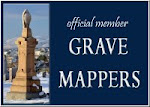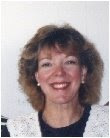


This was a fun challenge! Here is Annie Elizabeth Wright, my husbands great grandmother.
The best part of the story is of how I got the cemetery picture. Grandma Annie is buried in Dallas, Texas. I planned to go to the cemetery when I got there from California, but nobody would go with me. I was a stranger so I wanted someone to go with me. Nobody would go. I called the cemetery and talked to the sexton, a very nice man, and he assured me she was there and he would take me to the grave. But still nobody that I knew would go with me. I called the local police to ask if it was safe to go there alone. This is what I was told after alot of hemming and hawing: :"A white girl in a late model car shouldn't go there." Well, now I am scared, but I still wanted a picture.
So this is what I did. I mailed a disposable camera and a self addressed stamped bubble envelope in another bubble envelope to the cemetery and enclosed a small donation and a note to please take photos of her grave. In a week or two I recieved it back. This darling man took the whole roll, every angle possible of the stone.
Now I always think of that story when I think of Annie E. Hockenberry Wright.












